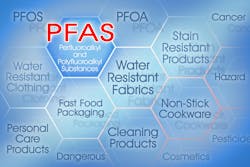Key Highlights
- We’ve got a patchwork quilt of regulations in the U.S. at the state level, and it’s becoming overwhelming for manufacturers who can’t keep up, especially since the laws are not harmonized.
- EHS professionals who may be responsible for tasks such as Chemical Data Reporting under TSCA 8(a) are suddenly playing in the Product and Trade compliance worlds with their compliance “cousins".
The focus on how to handle the regulatory requirements for PFAS continues, so EHS Today asked Cally Edgren, vice president, regulatory & sustainability at Assent, to update a 2023 conversation, "New Required Reporting on PFAS Defines New Regulatory Environment."
Q: How has the PFAS regulatory climate evolved over the past couple of years?
CE: While laws continue to develop through the usual mechanisms at the federal level in the U.S. and the block-level in the EU, we continue to see smaller jurisdictions — U.S. states and EU Member States — moving faster. We’ve got a patchwork quilt of regulations in the U.S. at the state level, and it’s becoming overwhelming for manufacturers who can’t keep up, especially since the laws are not harmonized.
Many of these laws are also under constant change — continued lobbying leading to numerous amendments and various agency interpretations that may or may not withstand legal challenges. It makes it difficult for manufacturers to develop action plans since the requirements may change before they’re through. Beyond the regulations, we continue to see non-regulatory drivers playing at least as much of a role in driving urgency via obsolescence, insurance, litigation and consumer expectations.
The laws continue to address numerous parts of the PFAS life cycle — from the manufacture, use and disposal of the chemicals themselves, and contamination caused by past operations, and consumer exposure from using products with PFAS.
Q: How are companies handling this in an efficient manner?
CE: The most proactive companies are addressing this issue on all sides — how they use and dispose of PFAS in their facilities, and how they use and distribute PFAS in their products.
They have already done the work to identify where PFAS are located in the materials they buy (both direct materials and indirect / MRO materials) and now understand their exposure. They can prioritize their next actions based on what kinds of PFAS they’re finding. For example, fluoropolymers such as PTFE may not drive the same level of urgency for redesign as substances like PFOA or PFOS that are included in the Stockholm Convention, CERCLA, the Drinking Water Regulation, etc.
I continue to see companies that aren’t coordinating their approach for both direct materials as well as indirect and MRO purchasing. They see this as a one-sided issue rather than the game-changer that it is. They haven’t invested their efforts in identifying what kinds of PFAS they’re using, nor planned for redesign or last time buys. As such, nobody in the company has a full view of their real risk, not just from regulation but also from litigation and obsolescence.
Q: Do you see any changes happening to compliance this year?
CE: Domestically, we will see more PFAS regulations focused on remediation of contaminated sites. The public pressure continues to ramp up — as people increasingly demand clean drinking water!
While the National Primary Drinking Water Regulation continues to evolve, ultimately it puts requirements on local municipalities to test and clean up drinking water. As we get closer to those deadlines, we’ll see much more activity. I’m hearing from many people across the country that their local water regulators are starting to include notes on their bills about PFAS contamination.
Internationally, we’ll also see more countries that are signatories to the Stockholm Convention beginning to implement national regulations for the PFAS included in that agreement. This is going to raise pressure on manufacturers who operate in multiple countries and/or sell products in multiple countries.
Q: Over the past couple of years, how has the role of EHS changed in helping companies comply with regulations?
CE: I’ve worked in both EHS and Product Compliance over my career, and historically, these groups didn’t work together all that often. But PFAS has been a topic that pulls these two sides together, as the laws have become complex enough that they’re intertwining these worlds.
For example, the EHS professionals who may be responsible for tasks such as Chemical Data Reporting under TSCA 8(a) are suddenly playing in the Product and Trade compliance worlds with their compliance “cousins”, so to speak, to understand what parts and products containing may have been imported for reporting under TSCA 8(a)(7). Most Product Compliance professionals have never entered data into the EPA’s CDX system, and they’ll be leaning on their EHS counterparts for support.
Q: In our last conversation, you said the following: “There needs to be the understanding that product compliance is now a revenue driver as customers are making buying decisions based on compliance with regulations, as evidenced by the market for non-PFAS clothing, for example.’ Has this played out during the past couple of years?
CE: This is absolutely playing out among consumer products — concerns about the health impacts of PFAS, microplastics, phthalates and other chemicals are gaining momentum. PFAS are only one part of the puzzle as we see both demand and requirements evolving to a more holistic view of what sustainable design is.
In the last few years, we’ve seen regulations like the EU’s Batteries Regulation and Ecodesign for Sustainable Products Regulation evolve from their more narrowly focused predecessors to include not only many new sustainability-focused design criteria, but also the requirement to provide more transparency around these features via “digital product passports” so consumers can make smarter buying decisions.
Q: Other things you are seeing concerning compliance?
CE: Many customers have told me over the last year that as they are changing out components in their factories for PFAS-free alternatives — either by choice or necessity, that’s driven by obsolescence — they’re experiencing equipment performance issues.
Maintenance is more frequent due to declining component durability, with valves and seals leaking oil and other materials onto their floors.
Additionally, chemicals used in some processes, such as electroplating, are no longer available. As fire extinguishing materials and systems are reformulated, EHS leaders and legal teams should be aware of potential changes to their insurance policies and insurers’ demands.
About the Author
Adrienne Selko
Senior Editor
Email [email protected]
Adrienne Selko is also the senior editor at Material Handling and Logistics and is a former editor of IndustryWeek.

